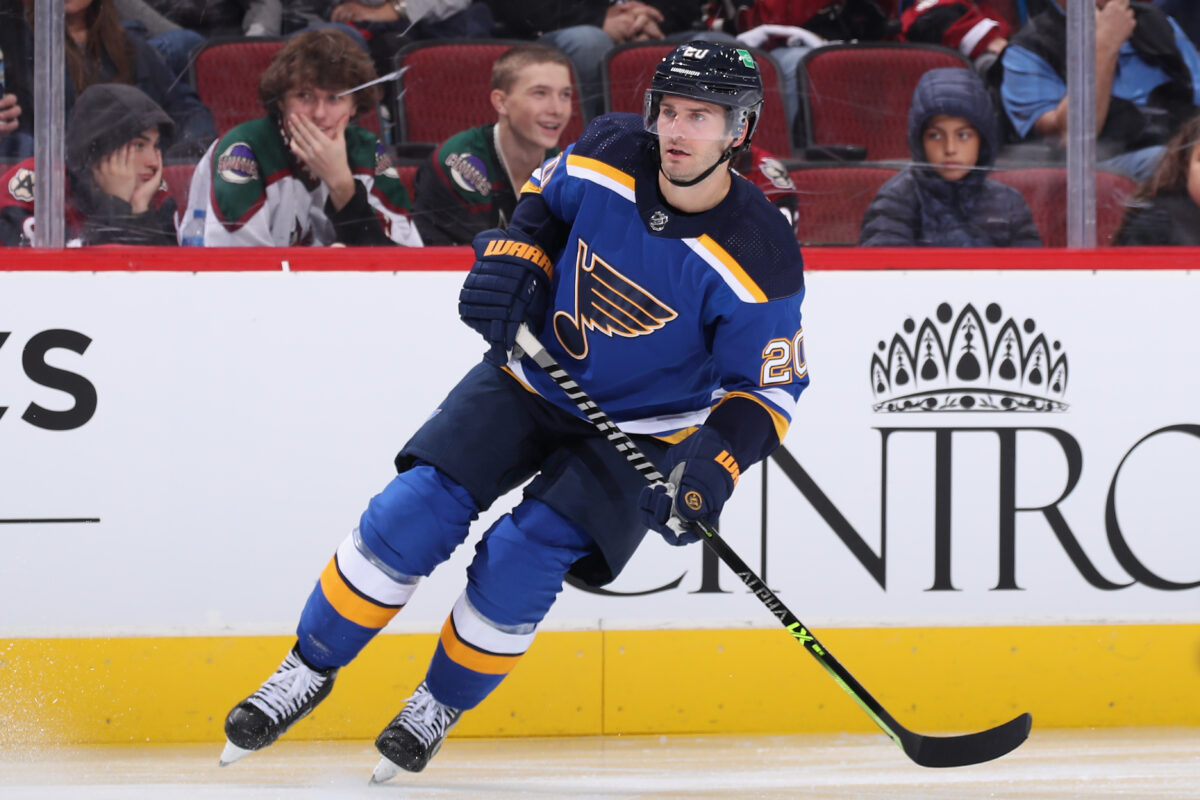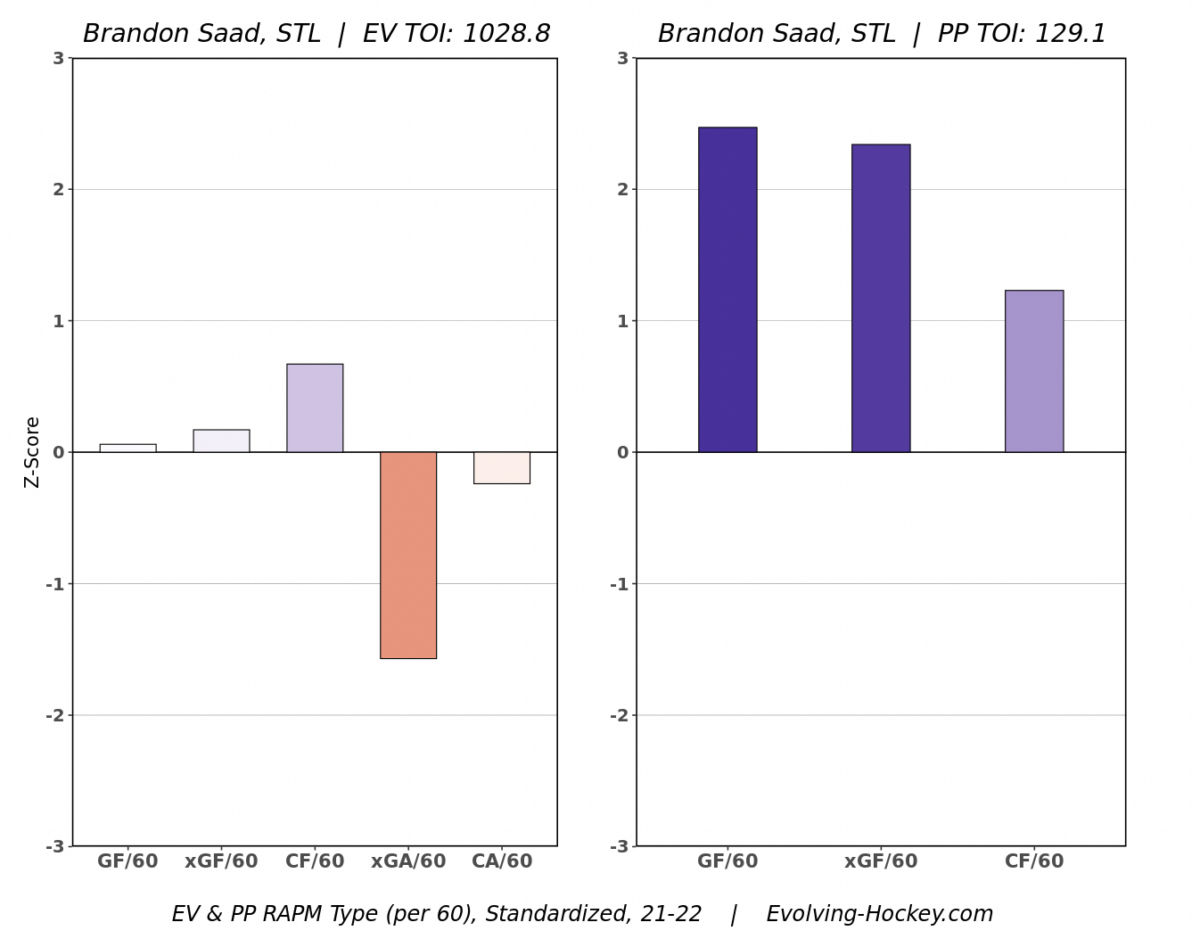The St. Louis Blues 2021-22 season represented a major transition for the franchise. No longer a stout defensive team built from the blue line out, they finished second in the NHL in goals scored, with nine forwards recording 20-plus. Though the season came to an end in a six-game defeat by the Colorado Avalanche in the second round, there are plenty of highs and lows to reflect on. In this series, we’ll evaluate each player who played 10 or more games with the team (as well as the head coach and general manager), grading their individual performance and looking at their future with the team.
Entering the 2021 offseason, it was clear the St. Louis Blues needed more scoring and more help on the wings. They got both by signing veteran winger Brandon Saad to a five-year, $22.5 million contract. The familiar foe had spent most of his career with division rivals in the Colorado Avalanche and the archrival Chicago Blackhawks, so the organization had a good idea what kind of player they were getting. But it wasn’t yet clear how the veteran would fit into the team’s framework. Over the course of the 2021-22 season, Saad would prove to be a valuable asset and a good signing.
What Went Right: Offensive Reinforcement
The Blues signed Saad to do two main things: provide a veteran presence and add scoring to the roster. Like fellow newcomer Pavel Buchnevich, Saad got off to a quick start and immediately rewarded the Blues for adding him to the fold. He collected eight goals in the first 14 games of the season and showed a willingness and ability to play up and down the lineup, something that will always put a player in the good graces of head coach Craig Berube.

By season’s end, Saad was one of the nine Blues forwards to score 20 goals, helping the team finish second in the league in goals scored. He finished the season with 24 goals and 25 assists in 78 games. 13 of his points came on the power play, helping the Blues finish with the second-best power play in the NHL.
In the postseason, Saad wasn’t necessarily an elite weapon, but he still contributed, scoring two goals and three assists in 12 games. He largely disappeared in the later games against his former team, the Avalanche, but the team struggled to find its footing after Jordan Binnington’s untimely departure. Saad certainly can’t be blamed for the loss any more than a number of other forwards who struggled to gain traction against one of the best teams in the league. All in all, his first season in St. Louis was a success on the offensive side of the puck.
What Went Wrong: Defensive Liability
If there was a weakness to Saad’s game, it was a tendency to be a passenger in the defensive end. This is nothing new — the Blues knew they weren’t signing a two-way forward when they added the veteran. But the Pittsburgh native’s struggles on defense are brought into stark relief in the below graphic from Evolving Hockey.

Notable in the above chart is the low score on expected goals against per 60 (xGA/60), measuring about 1.5 standard deviations below league average. Saad allowed too many high-quality opportunities to his opponents. But that’s not much different from many of his teammates. The team’s identity shifted this season, and they became much more of a free-flowing high-scoring team.
Related: Blues Forward Depth is Team’s Greatest Strength
But the right side of the chart shows exactly what Saad brought to the table: he helped the team score goals in bunches, especially with the extra man. The Blues knew the kind of player they were signing, and if they weren’t satisfied with these results, they have no one to blame but themselves.
Key Facts
- 49 points is best season since career-high in 2016-17
- 24 goals matches total from 2016-17, the second-best goal-scoring season of his career
- Lowest amongst regular players with 10 PIM
Final Grade: B
There’s no complaining about what Saad brought to the table this season. But as a $4.5 million forward, a lot is expected of him, which keeps his grade from climbing even higher. His 24 goals and 49 points were both close to career highs, and he didn’t miss a beat in helping the Blues’ power play remain one of the best in the league. He wasn’t strong on defense — an area the Blues need to improve going into next season — but if he can continue to surpass 20 goals a season, the Blues won’t have any regrets about signing him.
What’s Next for Saad?
Saad seems to have found a long-term NHL home. Barring an unforeseen change of circumstances, he’ll remain in the Blues’ organization for at least four more seasons. It’s probably too much to help a leopard changes his spots as far his defensive woes go. But the best thing Saad can do for next season is to find a permanent home in the lineup, and build chemistry with a particular set of teammates. He became a swiss army knife, moving up and down the lineup as needed. That’s a valuable skill, but he’ll be more stable with a fixed set of linemates, and more likely to do what the team needs him to do most: score. if he continues to do that, the marriage between the Blues and the ex-Blackhawk will continue to be a happy one.